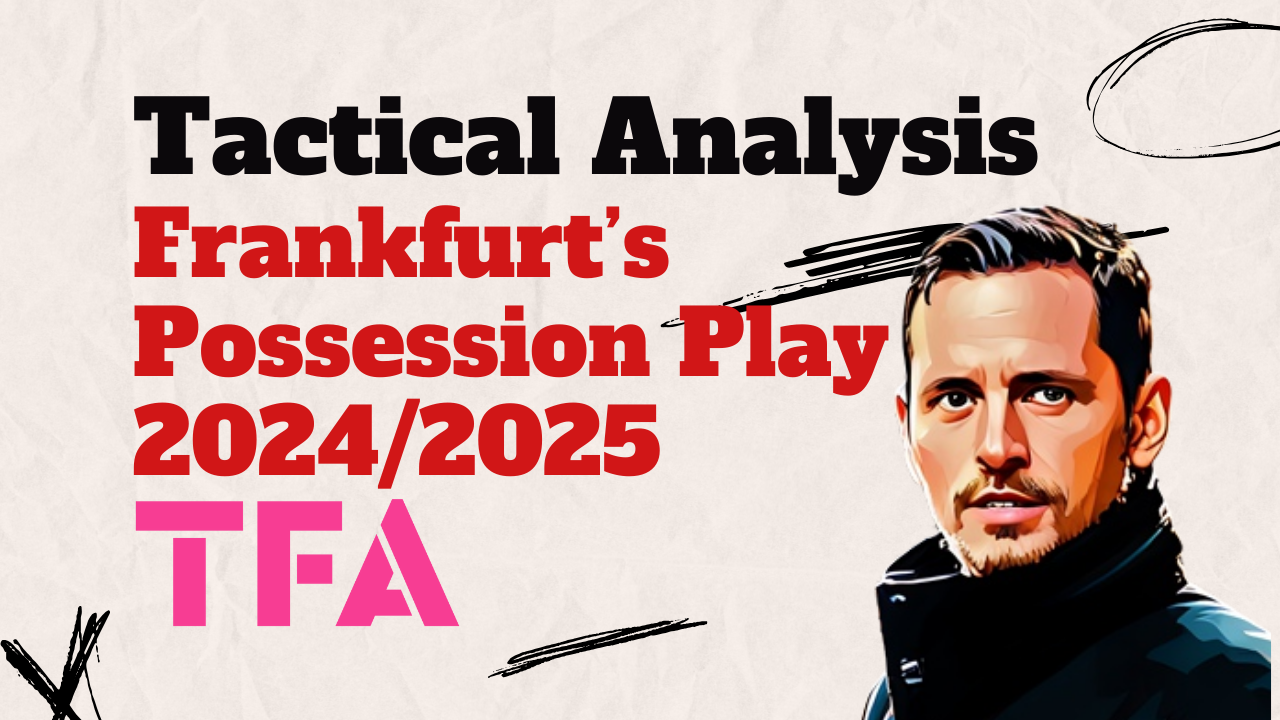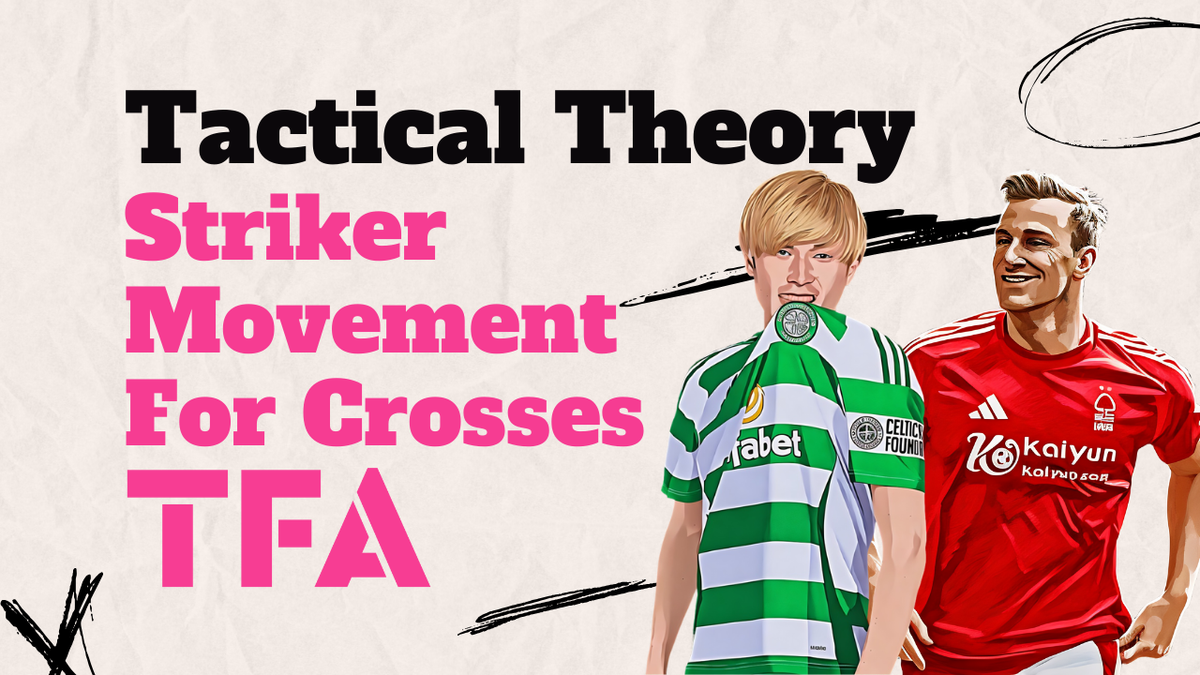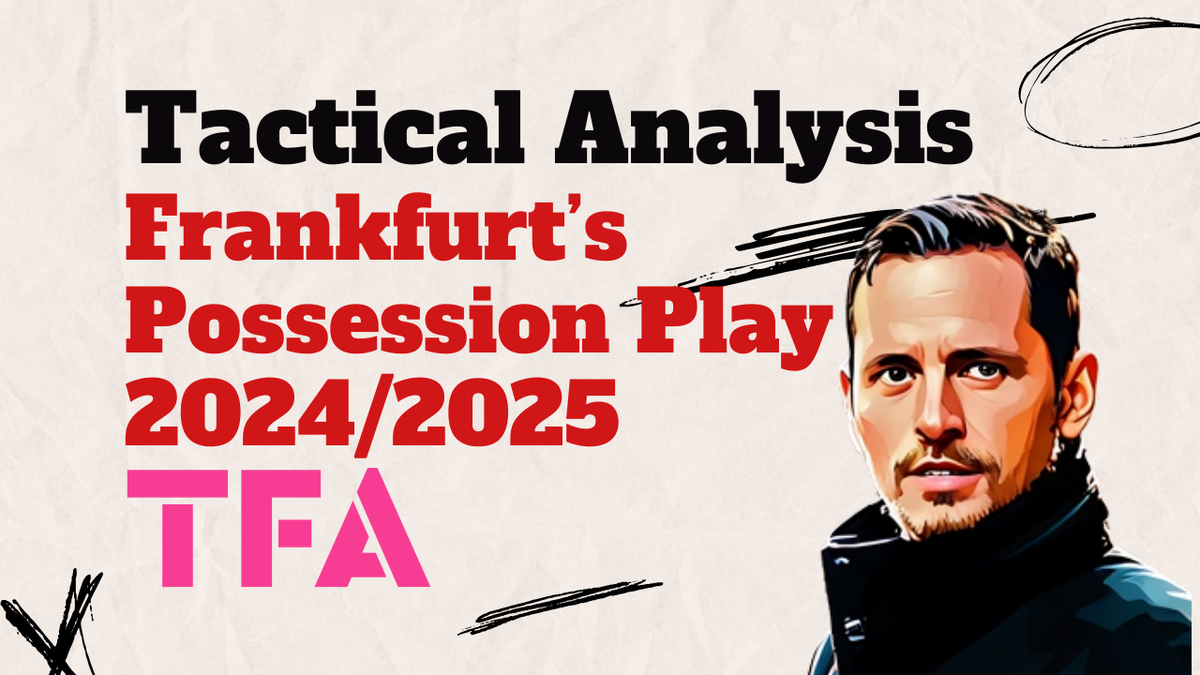Eintracht Frankfurt have had an outstanding first half of the season, finishing the first round in third place in the Bundesliga.
The team has consistently created goalscoring opportunities through effective transition play.
In particular, the two pacey forwards, Omar Marmoush and Hugo Ekitiké, benefited from this style of play.The large spaces created allowed them to fully exploit their speed advantage.
However, there have been difficulties against compact opponents, which could become a significant issue as the second half of the season progresses.
Before the winter break, Eintracht Frankfurt struggled to maintain the strong form they displayed during the first 12 matchdays.
A clear trend emerged during this period: the team had significantly more possession than at the start of the season.
Frankfurt’s style of play is heavily reliant on their transition game.
When opponents allow the team more possession and defend in a compact shape, Frankfurt often struggle.
This is by no means a new phenomenon.
Markus Krösche, Dino Toppmöller, and others referred to a lack of “heavy metal football” as early as last season.
During possession phases, Frankfurt lacked ideas to break down the opposition’s defensive block, resulting in less attractive games for spectators.
Over the summer, Toppmöller adjusted the team’s playing style.
The formula for success was reduced possession, combined with dangerous transitions supported by a particularly effective “rest attack.”
Opponents have logically responded by conceding less possession to minimise Frankfurt’s offensive transition opportunities.
But what do Frankfurt lack in possession to break down a compact opponent?
This article will explore the reasons behind Frankfurt’s “boring” possession game and examine the options available to Toppmöller to create more scoring opportunities during possession phases.
Finally, the article will analyse the possession game against Freiburg as a positive example.
Eintracht Frankfurt Problems In Possession
In contrast to teams like Brighton under Fabian Hürzeler, Eintracht Frankfurt employ clear positional assignments.
Frankfurt typically utilise a 4-2-4 structure during opposition pressing, while against deeper defensive blocks, they shift to a 3-2-5 setup.
Classical positional play forms the foundation of Frankfurt’s build-up strategy.
Occupying specific zones, drawing out certain opponents, and finding the free man are key principles of their positional approach.
The result is intentionally large distances between players, designed to force the opposition to shift and open up certain spaces.
However, this often requires overcoming many stations before a dangerous attacking action can be initiated.
Finding the free man can take considerable time.
If the opposition shifts consistently and minimises errors, the ball can be circulated for long periods without penetrating dangerous areas.
The issue with Frankfurt’s often “sluggish” positional play against deep-lying opponents is that the opposition typically defends their goal in a highly compact, space-oriented manner, leaving few gaps to exploit.
This leads to an even longer search for the free player and usually results in few scoring opportunities for either side.
Due to the compact shifting of the opposition, the ball-possessing team often lacks at least two-three passing options because these players are positioned in other areas farther from the ball.
Switching play to these players takes so long that the opposition has time to close off the crucial spaces.

Another noticeable aspect of Frankfurt’s game is that depth is usually created along the sidelines, starting from the first build-up line.
During build-up play, players in the centre or half-spaces are rarely found by the back three.
As a result, the options for the player in possession are very limited, as the sideline also restricts their actions.

This is partly due to a lack of variability and positional rotations.
Opponents can adapt to fixed patterns and are repeatedly confronted with the same attacking strategies and matchups.
This results in fewer forced, spontaneous situations for the opposition defenders and, consequently, fewer errors by the opponent.
For Frankfurt’s build-up players, the only “simple” option often remains to play down the flanks.
Another issue in Frankfurt’s possession play is the lack of tempo from the build-up line.
Slower switches of play give the opponent more time to shift their defensive shape.
However, this problem is also influenced by a lack of vertical movements from teammates in the advanced lines.
Missing runs into or from depth result in a lack of diagonal passing options, contributing to the build-up players’ slow tempo.
Frankfurt, therefore, struggles to generate the diagonal play that is so difficult for opponents to defend.
Just before the winter break, Frankfurt conceded 13 goals in five games.
While most of these goals were not the result of opposition counterattacks, there remains significant potential for improvement in this area.
Frankfurt, especially in the two matches against Leipzig, rarely managed to create counterpressing situations to prevent counterattacks or extended opposition possession phases.
They also did not capitalise on ball recoveries to create dangerous scoring opportunities.
This issue could also stem from a lack of verticality in Frankfurt’s possession play.
The following statistic supports the perception of missing counterpressing situations against Leipzig.
According to Wyscout data, Frankfurt managed only 10 and 12 high recoveries, respectively, in their matches against Leipzig despite averaging 60% possession.
For comparison, Bayern Munich, with a similar possession share, average over 20 high recoveries per match this season.
In general, problems out of possession can often be mitigated during possession phases if successful counterpressing prevents the opponent from creating dangerous chances.
Thus, issues out of possession could be partially resolved by improving play in possession.
It can be concluded that the characteristics of positional play, with long possession phases and fewer transitions, seem ill-suited to Eintracht Frankfurt.
The current approach of “structured” possession phases does not align with Frankfurt’s underlying footballing philosophy.
As a result, the execution of a possession-based style that does not play to the team’s strengths has been poor.
Frankfurt has struggled to create scoring opportunities “by design” from structured possession phases due to a lack of verticality.
Vertical Possession Play – An Alternative For Eintracht Frankfurt
The goal of “structured” possession should be to constantly attack and stress the opponent.
The solution is to create as much verticality as possible while maintaining or improving pressing resistance.
Possession play should be as variable as possible to make a compact opponent difficult to defeat.
This way, the opponent is faced with different challenges that are harder to anticipate.
A style known for its variability is relationism.
The opponent is presented with a wide range of challenges by creating extreme overloads focused on the ball rather than on specific zones.
Relational play allows players to be much freer than positional play, which creates a more unpredictable style and makes it harder for even compact opponents to defend.
However, the ball focus also leads to high possession statistics.
For example, when the opponent presses high, the ball-near side is overloaded.
While this increases pressing resistance, it also reduces attacking penetration.
A blend of both playing styles would be ideal for Eintracht Frankfurt, maximising their strengths.
The foundation of positional play could be used to situationally overload certain areas, creating space for more dynamic attacking options.
Eintracht Frankfurt Overloads
Depending on the opponent, game situation, and their own strengths, Eintracht Frankfurt should vary between different (situational) overloads.
Overloads that promote vertical play would particularly benefit Frankfurt as they would create more transition opportunities.
If the opponent defends compactly with a high defensive line, Frankfurt should overload the last line of defence.
With an overload in the opponent’s last line, overloaded players can be found in depth.
The opponent must repeatedly cover the deep runs, forcing their defenders to drop back.
This creates a larger space between the opposition’s defence and midfield, breaking the compactness.
Frankfurt wouldn’t need to rely on completely new structures for this.
In the familiar formations of 4-2-4 and 3-2-5, many players are already positioned along the last line.
The issue for Frankfurt lies primarily in the lack of fluidity.
The overload is not effective because the players remain static on the last line.
The opponent can prepare for this and close passing lanes.
Additionally, there are too few deep runs from the five attacking players, which would help pull the opponent’s defensive block apart.

Ideally, different players should consistently look for various ways to attack in depth, with the same goal of overloading the last line.
To move away from the “Long-Line” approach in a “U-formation” and build more through the centre or half-spaces, Frankfurt can situationally overload the centre.
Overloads in the centre can easily be created from both the frequently used 4-2-4 and 3-2-5 formations.
It’s important to note that these overloads should also be fluid.
This means that the overloaded players should not remain static in the centre, trying to congest it.

Other overloads to promote vertical play include overloading the half-spaces and the space between the lines.
These are particularly effective against compact opponents due to the freedom these areas offer.
On the one hand, the pressure from the opponent is lower; on the other, the players in possession have more freedom to make decisions.
Numerical superiority can be created in these spaces, making it easier to generate depth.
Again, fluidity is crucial to prevent the occupied spaces from becoming congested.
To illustrate, here is an example from Manchester City in this UEFA Champions League season.

Due to this back pass, options must be created for Stones to avoid losing further ground and prevent the opponent from setting up a potential pressing situation.

City temporarily created a 5v1 or 5v3 overload in the space between the lines, centrally in front of the goal.
As a result, Stones could easily bypass the first defensive line, allowing City to attack the next line with a numerical advantage.
Specific triggers or principles for overloads could be established to promote fluidity and situational overloads.
Possible examples could include: creating overloads in the ball-near half-space (+2) against the opponent’s compact lines, looking for overloads on the last line (+1) against a high defensive line, or overloading the centre (+2) during build-up play from the defensive line.
Eintracht Frankfurt Countermovements & Rotations
The lack of “free” movements is a primary reason for the absence of depth passing options, despite having five players on the opponent’s last line in the commonly used 3-2-5 formation.
Rotations can play an important role against the opponent’s man-marking.
Frankfurt, too, rarely manages to pull individual man-marking players out of position through rotations.
Man-marking is especially common on the wings and sometimes in central midfield.
A model for this could be the positional rotations seen at FC Bayern.
Players like Kane, Musiala, and Davies frequently swap zones dynamically, making it very difficult for the opponent to isolate individual players through man-marking.
As illustrated in the overload pictures, players in overload situations should look for diagonal countermovements.
This puts the opponent at a numerical disadvantage and forces them into a dilemma, thus increasing the effectiveness of overloads and ensuring constant movement from the opposition.
Brighton’s style of play could be a model for this.
It creates a lot of depth through overloads and countermovements from its own possession play.

Many other possible variations of countermovements can put the defence in dilemmas.
Examples could include movements between the central midfielders/forwards, full-backs/wingers, full-backs/holding midfielders, or even the ball-far full-back/forward.
The in-depth analysis of Brighton’s play
is linked here.
Layoff Play & Playing Into Pressure
Another problem in Frankfurt’s play is the lack of layoff options after a vertical pass.
Too often, the connection option is not found after a deep pass through one or more of the opponent’s lines.
Many ball losses in vertical play are the result.
This is especially noticeable when there are no ball-near movements from Frankfurt’s 3-2-5 formation.
Too many players operate on the same level.
In the Bundesliga match against St. Pauli, Frankfurt found players in half-space in front of the opponent’s half-space defender, which put them in a dilemma between applying pressure and securing depth.
However, Frankfurt was rarely able to capitalise on these passes.
Too often, layoff options were missing to retain possession behind the bypassed defensive line.

Frankfurt was still able to create depth from these situations.
Marmoush repeatedly turned around his defender in these moments.
However, should Marmoush move to Manchester City, Frankfurt will face significant problems, especially due to the underdeveloped layoff play.
The layoff play directly benefits from overloads.
More players mean more passing options.
What matters is the positioning within the overload.
Players should create as many different levels and passing angles as possible.
In this regard, Frankfurt could take inspiration from Stuttgart’s play.
In transition play, the center is repeatedly overloaded, and players never occupy positions at the same height.
The positioning and movements are crucial.
Generally, ball-near movements create passing options, as different levels are “fluidly” occupied.
A possible principle for more effective layoff play could be that the closer to the ball, the more movement.
In addition to the principles of movement and player height alignment, certain relational formations could be used as the foundation for an overload to create diagonal passing options.
One example of this would be the “Escadinha” (translated as stairs).
This describes a diagonal arrangement of several players.
With a pass into depth, multiple passing options can immediately be created through specific movements.

Starting from strong fluidity, Bayern Munich forms a “ladder” with three players.

This relational formation makes it easier to develop effective layoff play.

The action leads to the 5-0 against Hoffenheim.
Here, I have linked another possibility of how this formation could be played out.
With the principles outlined, Frankfurt would find it much easier to create an effective game under pressure, constantly putting the opponent in difficult defensive situations.
From Frankfurt’s perspective, playing under pressure would also be advantageous compared to the previously practiced search for the free player.
Under pressure, counterpressing becomes significantly more effective.
On one hand, many of Frankfurt’s players are positioned near the ball.
Conversely, after winning the ball, the opposing players are positioned too closely for a quick passing chain and must first spread out from their defensive positions.
Eintracht Frankfurt Counterpressing
Ironically, ball losses could play an important role in possession play.
The intentionally risky play into depth can provoke ball losses.
A principle that could be applied here is that the risk of action determines the defensive response.
Such ball recoveries can be used as a “playmaker” through counterpressing and force transition situations.
Why can counterpressing be so important as an offensive tool against compact teams?
Due to the ball loss, the opponent finds themselves in an offensive transition situation.
The ball recovery creates spaces to be exploited as the opposing players move out of their organised defensive structure during the offensive transition.
Both overloads in central areas and the described formations in layoff play have a positive impact on counterpressing.
More players near the ball also means more access to the ball when it’s lost.
The vertical structure of the layoff play simultaneously ensures defensive coverage.
The opponent has to bypass multiple levels.
How Eintracht Frankfurt Showcase Player Strengths
Frankfurt’s possession game should be designed in a way that maximises the individual strengths of its players.
How can I get the fast, dribbling, and finishing-strong Ekitiké into 1v1 situations with as much space as possible and as close to the opponent’s goal as possible, even against compact teams?
Using the “free player” could be one possible option.
The free player has the privilege of moving pretty much anywhere on the field.
The goal is for him to create overloads in the ball-near areas situationally and step out of his usual position, making him harder for the opponent to track.
Examples of this include Florian Wirtz at Bayer Leverkusen or Raphinha at Barcelona.
One possible variation could look like this:
Similar to Raphinha at Barcelona, Ekitiké could overload the gap between the half-space and the space between the lines immediately in front of the opponent’s defensive line as a ball-far “free” player.
In this combination of space between the half-space and between lines, it is particularly difficult for the opponent to control the possession team.
By overloading as a typically ball-far player, the opponent often fails to recognise the numerical disadvantage quickly enough and counter it.

Another way to highlight Ekitiké’s strengths is through half-space overloads and half-space shifts.
By overloading the half-space, the opponent is drawn to one side.
The defending team must close both the wing and the centre.
This opens up the opposite half-space, where Ekitiké is positioned.
Nagelsmann uses Wirtz and Musiala in the German national team in the opposite half-spaces.
This works especially well against 5-3-2 systems, as the midfield is forced to shift.
The overload of a half-space amplifies this effect.

Wirtz and Musiala are positioned in the opposite half-spaces.
By playing in the half-space, Hungary are forced to shift.

The half-space to half-space shift creates a lot of space for Musiala.
Ekitiké’s dribbling and 1v1 abilities can also be strategically used to draw the opponent in and create space in other areas.
Musiala often operates in a similar way for Bayern and the national team.
He holds the ball through dribbling in the half-space before the opponent’s defensive line.
This causes most defenders to focus on Musiala, opening up spaces behind the defensive line.
A player who has been very well utilised by Toppmöller in possession is left-back Nathaniel Brown.
The full-back is often compared to Mario Götze due to his excellent spatial awareness and understanding of the game, which makes him particularly suited for the half-space.
Brown is often found in these areas.
However, there is room for improvement.
Overloading the centre and the half-space would complement Brown’s style of play.
For players with a particularly deep understanding of the game, it is ideal to focus more on the option (e.g., relational overloads) rather than on structure (e.g., positional systematics).
The fluidity in the overloads described above would also suit Brown well, as he would be harder for the opponent to pin down in key areas.
In contrast,
left-back Nkounkou’s current weaknesscan also be traced to his positioning with the ball in positional play.
Nkounkou’s strengths lie in his speed and 1v1 ability on the wing.
Therefore, a similar positioning to Brown’s would be completely unsuitable for him.
Instead, Nkounkou could be used similarly to Davies at Bayern, making countermovements with the striker to bypass the defensive line.
Overloading the center could also benefit Nkounkou, as it would open up the wing for 1v1 situations with more space.
Other players, such as Matanovic, Bahoya, Uzun, etc., could also maximise their strengths in possession play by being positioned explicitly in certain areas.
A key element, however, is freeing up these spaces through overloads in other zones or creating overload situations in those areas.
Classification Of The 17th Matchday Against Freiburg
A positive example of Frankfurt’s ball possession play is the match against Freiburg.
Frankfurt repeatedly managed to create depth from their own ball possession.
This was also due to a freer movement of the front five players from the last line, often making runs into depth.
Götze, in particular, frequently sought to move out of his usual position, creating constant positional rotations.
Marmoush, Ekitiké, and Brown made more counter movements.
Additionally, even with less promising passes, Frankfurt consistently played forward to be able to switch to counterpressing afterward.
However, it should be noted that Freiburg, unlike teams like Leipzig, did not defend “standing” but rather “pressing.”
This creates higher pressure on the ball carrier and more movement on the field, which benefits Frankfurt’s current offensive approach.
As a result, Frankfurt players did not always need to pull Freiburg out of their compact structure and force movement against a “standing” opponent.
Nevertheless, softening the positional play and increasingly transitioning into asymmetric overloads remains necessary in Frankfurt’s ball possession game.
Anything Else?
There are, of course, other ways to play against deep-lying opponents.
Problems with creating scoring chances from possession can be masked through set pieces and transitions following successful high pressing.
More efficient attacking pressing leads to more offensive transition opportunities and simultaneously increases defensive stability.
However, the goal of consistently applying pressure to the opponent in every phase of the game will not be achieved without a more dangerous possession-based game.
Conclusion
Frankfurt surprised with incredibly good transitional football in the first half of the season.
They are rightly in third place in the Bundesliga, just behind Leverkusen and Bayern Munich.
It will be interesting to see if Frankfurt can perform similarly under Toppmöller in the second half of the season against teams that are better prepared for them.
More goalscoring threat through vertical play from “structured” possession phases is essential to build on the successful first half and potentially compensate for the departure of Marmoush.
The described adjusted tactical approach could better align with Frankfurt’s playing philosophy and strengths.





Comments